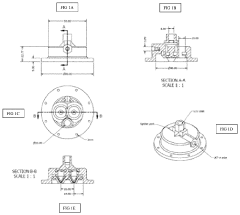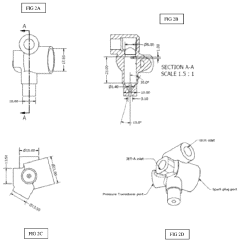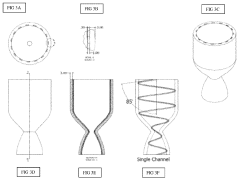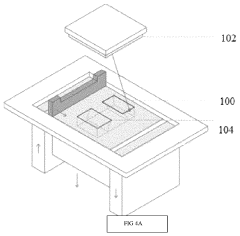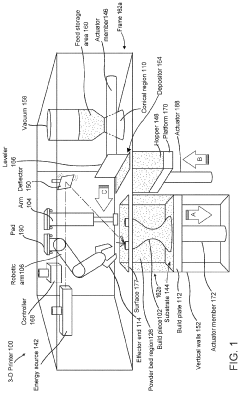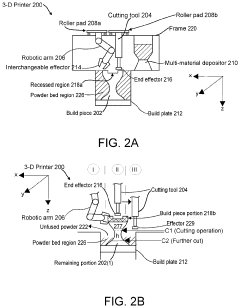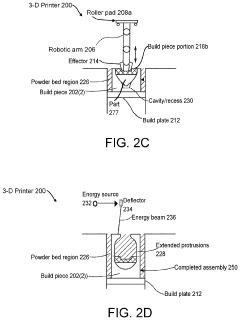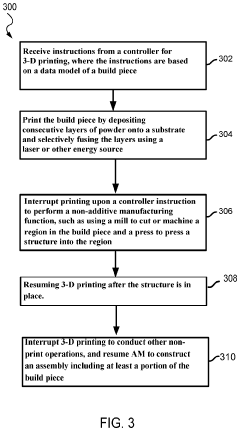K24 Engine and 3D Printing: Exploring Manufacturing Frontiers
JUL 3, 20259 MIN READ
Generate Your Research Report Instantly with AI Agent
Patsnap Eureka helps you evaluate technical feasibility & market potential.
K24 Engine and 3D Printing Background
The K24 engine and 3D printing represent two significant technological advancements that are reshaping the manufacturing landscape. The K24 engine, developed by Honda, is a 2.4-liter inline-four engine known for its efficiency and performance. It has been a staple in various Honda and Acura models since its introduction in the early 2000s. The engine's design emphasizes lightweight construction, high power output, and fuel efficiency, making it a benchmark in its class.
3D printing, also known as additive manufacturing, has evolved from a niche prototyping technology to a revolutionary manufacturing process. This technology builds three-dimensional objects by depositing materials layer by layer, based on digital models. It has gained significant traction across various industries, including aerospace, automotive, healthcare, and consumer goods.
The convergence of K24 engine technology and 3D printing represents a frontier in manufacturing innovation. This intersection offers potential for enhancing engine performance, reducing production costs, and enabling rapid prototyping and customization. 3D printing techniques can be applied to create complex engine components with improved designs that were previously impossible or impractical to manufacture using traditional methods.
The evolution of both technologies has been driven by the demand for more efficient, lightweight, and customizable products. The K24 engine has undergone several iterations, each improving upon its predecessor in terms of power output, fuel efficiency, and emissions reduction. Similarly, 3D printing has progressed from basic plastic prototyping to advanced metal printing capabilities, opening up new possibilities in engine component manufacturing.
As we explore this manufacturing frontier, several key objectives emerge. These include optimizing engine performance through innovative component designs, reducing production lead times, enabling mass customization of engine parts, and potentially revolutionizing the spare parts and aftermarket industries. Additionally, there is a focus on improving sustainability in manufacturing processes, as 3D printing can potentially reduce material waste and energy consumption compared to traditional subtractive manufacturing methods.
The integration of these technologies also aims to address challenges in the automotive industry, such as the need for rapid product development cycles, cost-effective production of complex parts, and the ability to quickly adapt to changing market demands. By leveraging the strengths of both the K24 engine design and 3D printing capabilities, manufacturers can potentially achieve new levels of efficiency and innovation in engine production.
3D printing, also known as additive manufacturing, has evolved from a niche prototyping technology to a revolutionary manufacturing process. This technology builds three-dimensional objects by depositing materials layer by layer, based on digital models. It has gained significant traction across various industries, including aerospace, automotive, healthcare, and consumer goods.
The convergence of K24 engine technology and 3D printing represents a frontier in manufacturing innovation. This intersection offers potential for enhancing engine performance, reducing production costs, and enabling rapid prototyping and customization. 3D printing techniques can be applied to create complex engine components with improved designs that were previously impossible or impractical to manufacture using traditional methods.
The evolution of both technologies has been driven by the demand for more efficient, lightweight, and customizable products. The K24 engine has undergone several iterations, each improving upon its predecessor in terms of power output, fuel efficiency, and emissions reduction. Similarly, 3D printing has progressed from basic plastic prototyping to advanced metal printing capabilities, opening up new possibilities in engine component manufacturing.
As we explore this manufacturing frontier, several key objectives emerge. These include optimizing engine performance through innovative component designs, reducing production lead times, enabling mass customization of engine parts, and potentially revolutionizing the spare parts and aftermarket industries. Additionally, there is a focus on improving sustainability in manufacturing processes, as 3D printing can potentially reduce material waste and energy consumption compared to traditional subtractive manufacturing methods.
The integration of these technologies also aims to address challenges in the automotive industry, such as the need for rapid product development cycles, cost-effective production of complex parts, and the ability to quickly adapt to changing market demands. By leveraging the strengths of both the K24 engine design and 3D printing capabilities, manufacturers can potentially achieve new levels of efficiency and innovation in engine production.
Market Analysis for 3D Printed Engine Components
The market for 3D printed engine components is experiencing significant growth, driven by the increasing demand for lightweight, high-performance parts in the automotive and aerospace industries. This innovative manufacturing technique offers several advantages over traditional methods, including reduced production time, lower costs, and the ability to create complex geometries that were previously impossible or impractical to manufacture.
In the automotive sector, the global market for 3D printed components is projected to expand rapidly in the coming years. Major automakers and suppliers are investing heavily in additive manufacturing technologies to produce engine parts such as pistons, cylinder heads, and turbocharger components. These 3D printed parts offer improved fuel efficiency and performance due to their optimized designs and reduced weight.
The aerospace industry is another key driver of the 3D printed engine components market. Leading aircraft manufacturers are adopting additive manufacturing to produce critical engine parts, including fuel nozzles, turbine blades, and combustion chamber liners. The ability to create complex internal cooling channels and lightweight structures has made 3D printing particularly attractive for aerospace applications.
The market for 3D printed engine components is also benefiting from advancements in materials science. New metal alloys and composite materials specifically designed for additive manufacturing are enabling the production of parts with superior mechanical properties and thermal resistance. This expansion of available materials is opening up new possibilities for engine design and performance optimization.
Small-scale production and customization represent growing niches within the 3D printed engine components market. Racing teams and specialty vehicle manufacturers are leveraging additive manufacturing to create bespoke engine parts tailored to specific performance requirements. This trend is expected to continue as 3D printing technologies become more accessible and cost-effective for smaller organizations.
Despite the promising growth prospects, challenges remain in the widespread adoption of 3D printed engine components. Quality control and certification processes for additively manufactured parts are still evolving, particularly for safety-critical applications. Additionally, the high initial investment costs for industrial-grade 3D printers and the need for specialized expertise can be barriers to entry for some manufacturers.
Looking ahead, the market for 3D printed engine components is poised for continued expansion as the technology matures and becomes more integrated into mainstream manufacturing processes. The development of hybrid manufacturing systems, combining additive and subtractive techniques, is expected to further enhance the capabilities and applications of 3D printing in engine production.
In the automotive sector, the global market for 3D printed components is projected to expand rapidly in the coming years. Major automakers and suppliers are investing heavily in additive manufacturing technologies to produce engine parts such as pistons, cylinder heads, and turbocharger components. These 3D printed parts offer improved fuel efficiency and performance due to their optimized designs and reduced weight.
The aerospace industry is another key driver of the 3D printed engine components market. Leading aircraft manufacturers are adopting additive manufacturing to produce critical engine parts, including fuel nozzles, turbine blades, and combustion chamber liners. The ability to create complex internal cooling channels and lightweight structures has made 3D printing particularly attractive for aerospace applications.
The market for 3D printed engine components is also benefiting from advancements in materials science. New metal alloys and composite materials specifically designed for additive manufacturing are enabling the production of parts with superior mechanical properties and thermal resistance. This expansion of available materials is opening up new possibilities for engine design and performance optimization.
Small-scale production and customization represent growing niches within the 3D printed engine components market. Racing teams and specialty vehicle manufacturers are leveraging additive manufacturing to create bespoke engine parts tailored to specific performance requirements. This trend is expected to continue as 3D printing technologies become more accessible and cost-effective for smaller organizations.
Despite the promising growth prospects, challenges remain in the widespread adoption of 3D printed engine components. Quality control and certification processes for additively manufactured parts are still evolving, particularly for safety-critical applications. Additionally, the high initial investment costs for industrial-grade 3D printers and the need for specialized expertise can be barriers to entry for some manufacturers.
Looking ahead, the market for 3D printed engine components is poised for continued expansion as the technology matures and becomes more integrated into mainstream manufacturing processes. The development of hybrid manufacturing systems, combining additive and subtractive techniques, is expected to further enhance the capabilities and applications of 3D printing in engine production.
Current Challenges in 3D Printing K24 Engine Parts
The 3D printing of K24 engine parts presents several significant challenges that currently limit its widespread adoption in manufacturing. One of the primary obstacles is achieving the required precision and surface finish for critical engine components. The K24 engine, known for its high performance and reliability, demands extremely tight tolerances and smooth surfaces to function optimally. Current 3D printing technologies often struggle to meet these exacting standards, particularly for components like cylinder heads, pistons, and crankshafts.
Material selection and performance pose another major challenge. While 3D printing offers a wide range of materials, including various metals and alloys, not all are suitable for the high-stress, high-temperature environment of an engine. Ensuring that 3D printed parts can withstand the extreme conditions inside a K24 engine, including thermal cycling and mechanical stress, remains a significant hurdle. This is particularly true for components that require specific material properties, such as heat resistance or wear resistance.
The issue of scalability and production speed also presents a considerable challenge. While 3D printing excels in prototyping and small-batch production, it has yet to match the efficiency of traditional manufacturing methods for large-scale production. This limitation is particularly evident when considering the volume of parts required for mass production of K24 engines. The time required to print complex engine components can be substantially longer than traditional manufacturing methods, potentially impacting production schedules and costs.
Quality control and consistency across printed parts is another area of concern. Unlike traditional manufacturing methods, which have well-established quality control processes, 3D printing of engine parts requires new approaches to ensure uniformity and reliability. Variations in print quality, even minor ones, can have significant impacts on engine performance and longevity. Developing robust quality assurance methods for 3D printed engine components remains an ongoing challenge.
Post-processing requirements present additional complications. Many 3D printed parts, especially those for high-performance engines like the K24, require extensive post-processing to achieve the necessary surface finish and dimensional accuracy. This can include machining, heat treatment, and surface treatments, which add time and cost to the manufacturing process. Streamlining these post-processing steps without compromising part quality is a key area of focus for researchers and manufacturers.
Lastly, the challenge of integrating 3D printed parts with traditionally manufactured components should not be overlooked. Ensuring seamless compatibility between printed and conventional parts, both in terms of fit and function, is crucial for the successful implementation of 3D printing in K24 engine manufacturing. This integration requires careful design considerations and may necessitate changes to existing engine designs to fully leverage the benefits of 3D printing technology.
Material selection and performance pose another major challenge. While 3D printing offers a wide range of materials, including various metals and alloys, not all are suitable for the high-stress, high-temperature environment of an engine. Ensuring that 3D printed parts can withstand the extreme conditions inside a K24 engine, including thermal cycling and mechanical stress, remains a significant hurdle. This is particularly true for components that require specific material properties, such as heat resistance or wear resistance.
The issue of scalability and production speed also presents a considerable challenge. While 3D printing excels in prototyping and small-batch production, it has yet to match the efficiency of traditional manufacturing methods for large-scale production. This limitation is particularly evident when considering the volume of parts required for mass production of K24 engines. The time required to print complex engine components can be substantially longer than traditional manufacturing methods, potentially impacting production schedules and costs.
Quality control and consistency across printed parts is another area of concern. Unlike traditional manufacturing methods, which have well-established quality control processes, 3D printing of engine parts requires new approaches to ensure uniformity and reliability. Variations in print quality, even minor ones, can have significant impacts on engine performance and longevity. Developing robust quality assurance methods for 3D printed engine components remains an ongoing challenge.
Post-processing requirements present additional complications. Many 3D printed parts, especially those for high-performance engines like the K24, require extensive post-processing to achieve the necessary surface finish and dimensional accuracy. This can include machining, heat treatment, and surface treatments, which add time and cost to the manufacturing process. Streamlining these post-processing steps without compromising part quality is a key area of focus for researchers and manufacturers.
Lastly, the challenge of integrating 3D printed parts with traditionally manufactured components should not be overlooked. Ensuring seamless compatibility between printed and conventional parts, both in terms of fit and function, is crucial for the successful implementation of 3D printing in K24 engine manufacturing. This integration requires careful design considerations and may necessitate changes to existing engine designs to fully leverage the benefits of 3D printing technology.
Existing 3D Printing Solutions for K24 Engine
01 3D printing of K24 engine components
Additive manufacturing techniques are being applied to produce parts for K24 engines. This allows for rapid prototyping, custom designs, and potentially lighter weight components. 3D printing can be used to create complex geometries that may be difficult to manufacture using traditional methods, potentially improving engine performance or efficiency.- 3D printing of K24 engine components: Additive manufacturing techniques are being applied to produce parts for K24 engines. This allows for rapid prototyping, customization, and potentially lighter weight components. 3D printing can be used to create complex geometries that may be difficult to manufacture using traditional methods, potentially improving engine performance or efficiency.
- Integration of 3D printing in K24 engine manufacturing processes: Manufacturers are incorporating 3D printing technologies into their production lines for K24 engines. This integration can streamline the manufacturing process, reduce lead times, and allow for more flexible production. It may also enable on-demand production of spare parts or custom components for K24 engines.
- 3D printed molds and tooling for K24 engine production: Additive manufacturing is being used to create molds, jigs, and other tooling used in the production of K24 engines. This can reduce tooling costs and lead times, especially for low-volume or custom engine variants. 3D printed tooling may also allow for more complex cooling channels or other features that can improve the casting or molding process.
- Materials development for 3D printed K24 engine parts: Research is being conducted on new materials suitable for 3D printing K24 engine components. This includes high-temperature resistant alloys, composites, and ceramics that can withstand the demanding conditions inside an engine. The development of these materials aims to improve the performance and durability of 3D printed engine parts.
- Quality control and testing of 3D printed K24 engine components: Advanced inspection and testing methods are being developed to ensure the quality and reliability of 3D printed K24 engine parts. This includes non-destructive testing techniques, in-situ monitoring during the printing process, and post-processing treatments to enhance the properties of printed components. These methods aim to validate the performance and safety of 3D printed engine parts for use in K24 engines.
02 Integration of 3D printing in K24 engine manufacturing processes
Manufacturing processes for K24 engines are being enhanced by incorporating 3D printing technologies. This integration can lead to more efficient production lines, reduced waste, and the ability to quickly iterate on designs. It may also allow for on-demand production of spare parts or custom components.Expand Specific Solutions03 Advanced materials for 3D printed K24 engine parts
Research is being conducted on advanced materials suitable for 3D printing K24 engine components. These materials may offer improved heat resistance, durability, or weight reduction compared to traditional engine materials. The use of such materials could potentially enhance engine performance and longevity.Expand Specific Solutions04 Quality control and testing of 3D printed K24 engine parts
Methods for ensuring the quality and reliability of 3D printed K24 engine components are being developed. This includes advanced inspection techniques, stress testing, and performance validation to ensure that 3D printed parts meet or exceed the standards of traditionally manufactured components.Expand Specific Solutions05 Customization and optimization of K24 engines using 3D printing
3D printing technology is enabling greater customization and optimization of K24 engines. This includes the ability to create bespoke components for specific applications, optimize internal geometries for improved performance, and potentially reduce the overall weight of the engine while maintaining or enhancing its power output.Expand Specific Solutions
Key Players in 3D Printed Engine Technology
The K24 Engine and 3D Printing technology landscape is in a dynamic growth phase, with the market expanding rapidly as industries recognize the potential for manufacturing innovation. The technology's maturity varies across applications, with some sectors already implementing advanced solutions while others are still in experimental stages. Key players like Stratasys, HP, and 3D Systems are driving innovation in additive manufacturing, while aerospace giants such as Northrop Grumman and Airbus are exploring its potential for engine components. Emerging companies like Divergent Technologies and Desktop Metal are pushing boundaries in automotive applications, indicating a competitive and diverse ecosystem. The integration of 3D printing with traditional manufacturing processes is becoming increasingly sophisticated, promising significant advancements in engine production efficiency and customization capabilities.
Stratasys, Inc.
Technical Solution: Stratasys has developed advanced 3D printing technologies specifically tailored for K24 engine manufacturing. Their FDM (Fused Deposition Modeling) technology allows for the creation of complex engine components with high precision and durability[1]. They have also introduced composite materials that can withstand high temperatures and pressures, making them suitable for engine parts[2]. Stratasys' PolyJet technology enables multi-material printing, allowing for the production of parts with varying mechanical and thermal properties within a single print[3]. This is particularly useful for creating intricate cooling channels and optimized fuel injection systems in K24 engines.
Strengths: High precision, multi-material capabilities, and ability to produce complex geometries. Weaknesses: Higher material costs compared to traditional manufacturing and limitations in large-scale production.
HP Development Co. LP
Technical Solution: HP has developed Multi Jet Fusion (MJF) technology, which is particularly suitable for K24 engine component manufacturing. MJF allows for the production of highly detailed and functional parts with isotropic mechanical properties[4]. HP's 3D printing solutions incorporate thermal management systems that enable the creation of complex cooling channels within engine components, improving overall engine efficiency[5]. Their technology also supports the use of engineering-grade thermoplastics that can withstand the high temperatures and pressures found in K24 engines. HP has recently introduced metal 3D printing capabilities, expanding the range of materials available for engine part production[6].
Strengths: High production speed, excellent surface finish, and ability to produce functional parts. Weaknesses: Limited material options compared to some competitors and higher initial investment costs.
Innovative 3D Printing Techniques for Engine Parts
Design and manufacturing of a single piece rocket engine
PatentActiveUS20230407821A1
Innovation
- A single piece, integrated propulsion engine is created using 3D printing, combining a combustion chamber, injector plate, igniter, and nozzle through additive manufacturing, eliminating the need for separate components and reducing mass and complexity by using laser powder bed fusion and direct metal laser sintering.
Three-dimensional printer and methods for assembling parts via integration of additive and conventional manufacturing operations
PatentActiveUS20210252803A1
Innovation
- A 3-D printer with integrated robotic arms and energy sources that allows for the interruption of AM processes to perform non-printing operations such as machining and assembly, enabling automated integration of additive and conventional manufacturing methods within a single machine.
Material Advancements for 3D Printed Engine Parts
The advancement of materials for 3D printed engine parts represents a critical frontier in the intersection of K24 engine technology and additive manufacturing. Recent developments have focused on enhancing the performance, durability, and efficiency of engine components produced through 3D printing processes.
One significant area of progress is in the development of high-temperature resistant alloys specifically tailored for additive manufacturing. These materials, often based on nickel or cobalt superalloys, are designed to withstand the extreme thermal and mechanical stresses present in modern engine environments. Researchers have made strides in optimizing the microstructure of these alloys during the 3D printing process, resulting in parts with improved creep resistance and fatigue strength.
Another promising direction is the exploration of ceramic matrix composites (CMCs) for 3D printed engine components. CMCs offer exceptional heat resistance and lightweight properties, making them ideal for applications such as turbine blades and combustion chambers. Recent advancements in 3D printing techniques have enabled the production of complex CMC structures with controlled porosity and fiber orientation, enhancing their overall performance.
The integration of functionally graded materials (FGMs) in 3D printed engine parts has also gained traction. FGMs allow for the seamless transition between different material properties within a single component, optimizing performance in areas subjected to varying thermal and mechanical loads. This approach has shown particular promise in the production of pistons and cylinder liners, where thermal management is crucial.
Nanocomposite materials have emerged as another area of focus for 3D printed engine parts. By incorporating nanoscale reinforcements into the base material, researchers have achieved significant improvements in strength, wear resistance, and thermal conductivity. These nanocomposites are particularly beneficial for components such as valve seats and bearings, where tribological properties are paramount.
Advancements in binder jet 3D printing technologies have opened up new possibilities for the use of metal matrix composites (MMCs) in engine parts. MMCs offer a combination of high strength, low weight, and excellent wear resistance, making them suitable for applications such as connecting rods and camshafts. The ability to precisely control the distribution of reinforcing particles within the metal matrix through 3D printing processes has led to optimized mechanical properties and enhanced performance.
One significant area of progress is in the development of high-temperature resistant alloys specifically tailored for additive manufacturing. These materials, often based on nickel or cobalt superalloys, are designed to withstand the extreme thermal and mechanical stresses present in modern engine environments. Researchers have made strides in optimizing the microstructure of these alloys during the 3D printing process, resulting in parts with improved creep resistance and fatigue strength.
Another promising direction is the exploration of ceramic matrix composites (CMCs) for 3D printed engine components. CMCs offer exceptional heat resistance and lightweight properties, making them ideal for applications such as turbine blades and combustion chambers. Recent advancements in 3D printing techniques have enabled the production of complex CMC structures with controlled porosity and fiber orientation, enhancing their overall performance.
The integration of functionally graded materials (FGMs) in 3D printed engine parts has also gained traction. FGMs allow for the seamless transition between different material properties within a single component, optimizing performance in areas subjected to varying thermal and mechanical loads. This approach has shown particular promise in the production of pistons and cylinder liners, where thermal management is crucial.
Nanocomposite materials have emerged as another area of focus for 3D printed engine parts. By incorporating nanoscale reinforcements into the base material, researchers have achieved significant improvements in strength, wear resistance, and thermal conductivity. These nanocomposites are particularly beneficial for components such as valve seats and bearings, where tribological properties are paramount.
Advancements in binder jet 3D printing technologies have opened up new possibilities for the use of metal matrix composites (MMCs) in engine parts. MMCs offer a combination of high strength, low weight, and excellent wear resistance, making them suitable for applications such as connecting rods and camshafts. The ability to precisely control the distribution of reinforcing particles within the metal matrix through 3D printing processes has led to optimized mechanical properties and enhanced performance.
Environmental Impact of 3D Printed K24 Engines
The environmental impact of 3D printed K24 engines represents a complex interplay of manufacturing processes, material choices, and lifecycle considerations. Additive manufacturing techniques, such as those employed in 3D printing K24 engines, offer potential environmental benefits compared to traditional manufacturing methods. These advantages stem from reduced material waste, localized production capabilities, and the ability to create complex geometries that can enhance engine efficiency.
One of the primary environmental benefits of 3D printing K24 engines is the significant reduction in material waste. Traditional subtractive manufacturing methods often result in substantial material loss, whereas additive manufacturing processes utilize materials more efficiently. This reduction in waste not only conserves raw materials but also minimizes the energy and resources required for material production and disposal.
The localized production potential of 3D printed K24 engines can lead to reduced transportation emissions. By enabling on-demand manufacturing closer to the point of use, the need for long-distance shipping of finished products or components can be diminished. This localization of production can contribute to a smaller carbon footprint associated with the engine's lifecycle.
However, the environmental impact of 3D printed K24 engines is not without challenges. The energy consumption during the printing process, particularly for metal-based additive manufacturing, can be substantial. The high temperatures and extended printing times required for complex engine components may offset some of the environmental gains achieved through material efficiency.
Material selection plays a crucial role in determining the overall environmental impact of 3D printed K24 engines. While some materials used in additive manufacturing can be recycled or biodegradable, others may pose challenges for end-of-life disposal or recycling. The development and adoption of more sustainable and recyclable materials for 3D printing engines remain active areas of research and innovation.
The potential for improved engine design through 3D printing techniques may lead to enhanced fuel efficiency and reduced emissions during the operational life of K24 engines. Complex internal structures and optimized cooling channels, which are difficult to achieve with traditional manufacturing methods, can be readily produced using additive manufacturing. These design improvements can contribute to better engine performance and lower environmental impact over the engine's lifespan.
Lifecycle assessment studies comparing 3D printed K24 engines to traditionally manufactured counterparts are essential for a comprehensive understanding of their environmental impact. Such assessments must consider factors such as raw material extraction, manufacturing processes, use-phase efficiency, and end-of-life scenarios. The results of these studies can guide future developments in 3D printing technologies and material science to further minimize the environmental footprint of K24 engine production.
One of the primary environmental benefits of 3D printing K24 engines is the significant reduction in material waste. Traditional subtractive manufacturing methods often result in substantial material loss, whereas additive manufacturing processes utilize materials more efficiently. This reduction in waste not only conserves raw materials but also minimizes the energy and resources required for material production and disposal.
The localized production potential of 3D printed K24 engines can lead to reduced transportation emissions. By enabling on-demand manufacturing closer to the point of use, the need for long-distance shipping of finished products or components can be diminished. This localization of production can contribute to a smaller carbon footprint associated with the engine's lifecycle.
However, the environmental impact of 3D printed K24 engines is not without challenges. The energy consumption during the printing process, particularly for metal-based additive manufacturing, can be substantial. The high temperatures and extended printing times required for complex engine components may offset some of the environmental gains achieved through material efficiency.
Material selection plays a crucial role in determining the overall environmental impact of 3D printed K24 engines. While some materials used in additive manufacturing can be recycled or biodegradable, others may pose challenges for end-of-life disposal or recycling. The development and adoption of more sustainable and recyclable materials for 3D printing engines remain active areas of research and innovation.
The potential for improved engine design through 3D printing techniques may lead to enhanced fuel efficiency and reduced emissions during the operational life of K24 engines. Complex internal structures and optimized cooling channels, which are difficult to achieve with traditional manufacturing methods, can be readily produced using additive manufacturing. These design improvements can contribute to better engine performance and lower environmental impact over the engine's lifespan.
Lifecycle assessment studies comparing 3D printed K24 engines to traditionally manufactured counterparts are essential for a comprehensive understanding of their environmental impact. Such assessments must consider factors such as raw material extraction, manufacturing processes, use-phase efficiency, and end-of-life scenarios. The results of these studies can guide future developments in 3D printing technologies and material science to further minimize the environmental footprint of K24 engine production.
Unlock deeper insights with Patsnap Eureka Quick Research — get a full tech report to explore trends and direct your research. Try now!
Generate Your Research Report Instantly with AI Agent
Supercharge your innovation with Patsnap Eureka AI Agent Platform!
